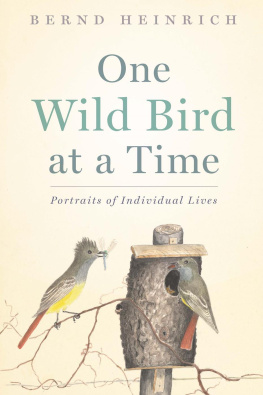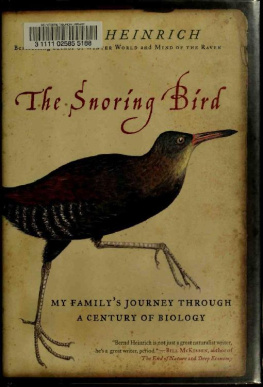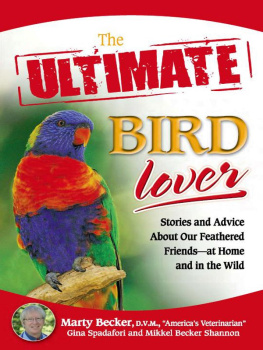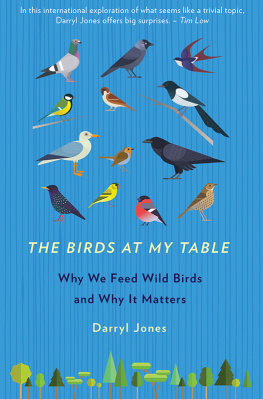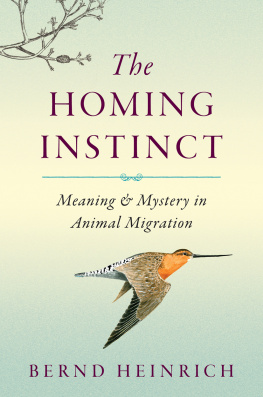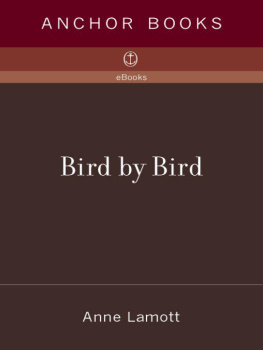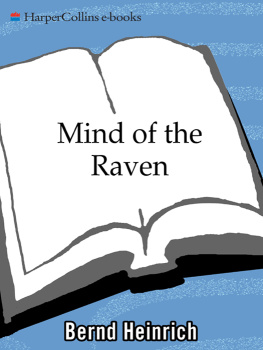Acknowledgments
B IRD WATCHING AND WRITING ARE BEST DONE SOLITARILY . However, making a book about the two may involve, among other things, suggestions and corrections, nudgings and judgings, and companionship of friends and kindred souls who critique and act as real or imagined sounding boards. In this case, they included (in no particular order) Alan Burger, Andrea Lawrence, Paul Spitzer, Lillian Reade, John Alcock, Margaret McVey, Greg Fell, Dean Leslie, Charles Sewall, Glenn Booma, Albert Reingewirtz, Andrea Lawrence, John Marzluff, Peter Miller, Duane and Nancy Leavitt, Lance Lichtensteiger, Alexandra and Garrett Conover, Joel Babb, and Lynn Jennings. Of these I acknowledge especially John Alcock for reading a draft of the manuscript and making valuable technical suggestions. I also thank my agent, Sandra Dijkstra, and Lynn Jennings, who have often nudged me in the right direction and helped me keep on course. I give sincere thanks to the editors and production staff of the publisher, Houghton Mifflin Harcourt, in this case specifically Camille Smith and Deanne Urmy, whose critical watchful eyes were in many cases more perceptive than mine. Last but not least, I have profited greatly from the generous support of Craig Neff and Pamelia Markwood, of the Naturalists Notebook of Seal Harbor, Maine, for digitizing, archiving, and storing almost all of my illustrations and making the appropriate ones conveniently available to be used for this publication.
Further Reading
F LICKERS IN THE H OUSE
Bent, Arthur C. 1939. Life Histories of North American Woodpeckers. Washington, DC: Government Printing Office. 342 pp.
Kilham, L. 1959. Early reproductive behavior of flickers. Wilson Bulletin 71:323336.
. 1983. Life History Studies of Woodpeckers of Eastern North America. Cambridge, MA: Nuttall Ornithological Club. 240 pp.
Sherman, A. R. 1910. At the Sign of the Northern Flicker. Wilson Bulletin 22:135171.
A Q UINTET OF C ROWS
Caffree, C. 1992. Female-biased delayed dispersal and helping in American crows. The Auk 109(3):609619.
Heinrich, B. 1999. Mind of the Raven: Investigations and Adventures with Wolf-Birds. New York: Harper-Collins. 380 pp.
Kilham, L. 1984. Cooperative breeding of American crows. Journal of Field Ornithology 55(3):349356.
. 1985. Behavior of American crows in the early part of the breeding cycle. Florida Field Naturalist 13(2):2548.
Marzluff, J. M., and T. Angell. 2005. In the Company of Crows and Ravens. New Haven, CT: Yale University Press. 384 pp.
Marzluff, J. M., J. Walls, H. N. Cornell, J. Withey, and D. P. Craig. 2010. Lasting recognition of threatening people by wild American crows. Animal Behaviour 79:699707.
Verbeek, N. A., and C. Caffrey. 2002. American Crow (Corvusbrachyrhynchos). The Birds of North America Online, ed. A. Poole. Ithaca: Cornell Laboratory of Ornithology. http://bna.birds.cornell.edu/BNA/
G ETTING TO K NOW A S TARLING
Baptista, L. F., and L. Petrinovich. 1984. Social interaction, sensitive periods, and song template hypothesis in the white-crowned sparrow. Animal Behaviour 36:175364.
Gentner, T. Q., K. M. Fenn, D. Margoliash, and H. C. Nusbaum. 2006. Recursive syntactic pattern learning by songbirds. Nature 440:120407.
Murmuration of Starlings. See http://www.youtube.com/embed/88UVJpQGi88.
West, M. J., A. N. Stroud, and A. P. King. 1983. Mimicry of the human voice by European starlings: The role of social interaction. Wilson Bulletin 95:635640.
West, M. J., and A. P. King. 1990. Mozarts Starling. American Scientist 78:106114.
W OODPECKER WITH A D RUM
Bent, A. C. 1939. Life Histories of North American Woodpeckers. Bulletin of the U.S. National Museum 174:11322. Reprinted by Dover Publications, New York, 1964.
Daily, G. C., P. R. Ehrlich, and N. M. Haddad. 1993. Double keystone bird in a keystone species mix. Proceedings of the National Academy of Sciences USA 90:592594.
Kilham, L. 1983. Life History Studies of Woodpeckers of Eastern North America. Nuttall Ornithological Club no. 20:1240.
Walters, E. L., E. H. Miller, and P. E. Lowther. 2002. Yellow-bellied Sapsucker (Sphyrapicus varius). The Birds of North America, no. 662, ed. A. Poole and F. Gill. Philadelphia: The Birds of North America, Inc.
B ARRED O WL T ALKING
Angell, T. 2015. The House of Owls. New Haven, CT: Yale University Press. 203 pp.
Bent, A. C. 1938. Life Histories of North American Birds of Prey, part 2. U.S. National Museum Bulletin, no. 170.
Eckert, A. W. 1974. The Owls of North America. New York: Doubleday.
Freeman, P. L. 2000. Identification of individual barred owls using spectrogram analysis and auditory cues. Journal of Raptor Research 34:8592.
Heinrich, B. 1987. One Mans Owl. Princeton, NJ: Princeton University Press. 224 pp.
Klatt, P. H., and G. Richison. 1993. The duetting behavior of eastern screech owls. Wilson Bulletin 105(3):483489.
Odum, K. L., and D. J. Merrill. 2010a. A quantitative description of the vocalizations and vocal activity of the barred owl. Condor 112:549560.
. 2010b. Vocal duets in nonpasserines: An examination of territorial defense and neighborhood-stranger discrimination in a neighborhood of barred owls. Behaviour 147:619639.
. 2012. Inconsistent geographic variation in the calls and duets of barred owls (Strix varia) across an area of genetic introgression. The Auk 129(3):387398.
H AWK T ABLECLOTHS
Berger, S., R. Disko, and H. Gwinner. 2003. Bacteria in starling nests. Journal of Ornithology 144:317322.
Brouwer, L., and J. Komdeur. 2004. Green nesting material has a function in mate attraction in the European starling. Animal Behaviour 67:539548.
Clark, L., and J. R. Mason. 1985. Use of nest material as insecticidal and anti-pathogenic agents by the European starling. Oecologia 67:169176.
Gracelin, D. H. S., A. J. Britto, and P. B. J. R. Kumar. 2012. Antibacterial screening of a few medicinal ferns against antibiotic resistant phytopathogens. International Journal of Pharmaceutical Sciences and Research 3:868873.
Gwinner, H., and S. Berger. 2005. European starlings: Nestling condition, parasites, and green nesting material during the breeding season. Journal of Ornithology 146:365371.
Gwinner, H., M. Oltrogge, L. Trost, and U. Nienaber. 2000. Green plants in starling nests: Effects on nestlings. Animal Behaviour 59:301309.
Heinrich, B. 2010. The Nesting Season: Cuckoos, Cuckolds, and the Invention of Monogamy. Cambridge, MA: Harvard University Press. 352 pp.
Heinrich, B. 2013. Why does a hawk build with green nesting material? Northeastern Naturalist 20(2):209218.
Hoffman, D. 2003. Medical Herbalism: Principles and Practice. Rochester, VT: Healing Arts Press. 588 pp.
Lyons, D. M., K. Titus, and J. A. Mosher. 1986. Sprig delivery by broad-winged hawks. Wilson Bulletin 98:469.
Matray, P. F. 1974. Broad-winged hawk nesting ecology. The Auk 91:307324.
Orians, G. F., and F. Kuhlman. 1956. The red-tailed hawk and great horned owl populations in Wisconsin. Condor 58:371385.
Rodgers, J. A., Jr., A. S. Wenner, and S. T. Schwikert. 1988. The use and function of green nest material by wood storks. Wilson Bulletin 100:411423.
Rosenfield, R. N. 1982. Sprig collection by a broad-winged hawk. Raptor Research 16:63.
Srivastava, K. 2007. Importance of ferns in human medicine.

